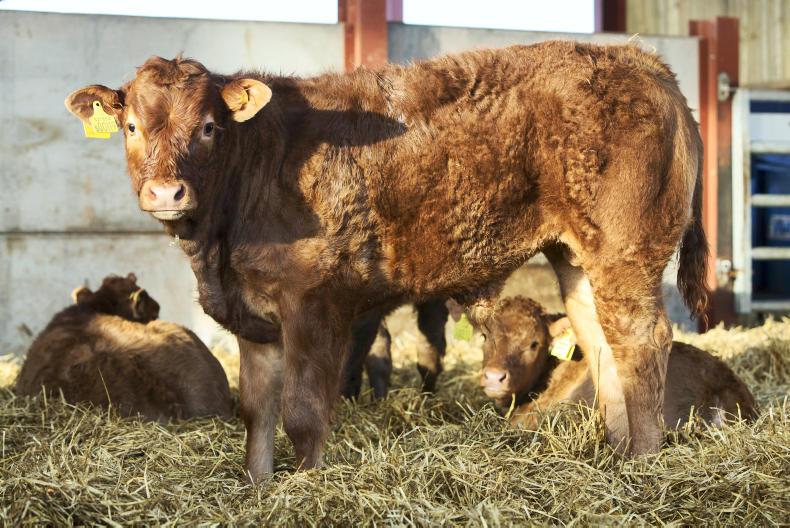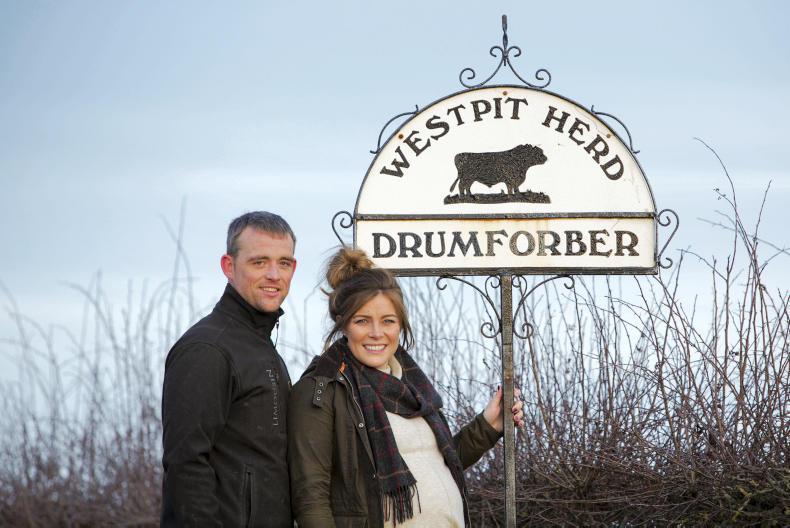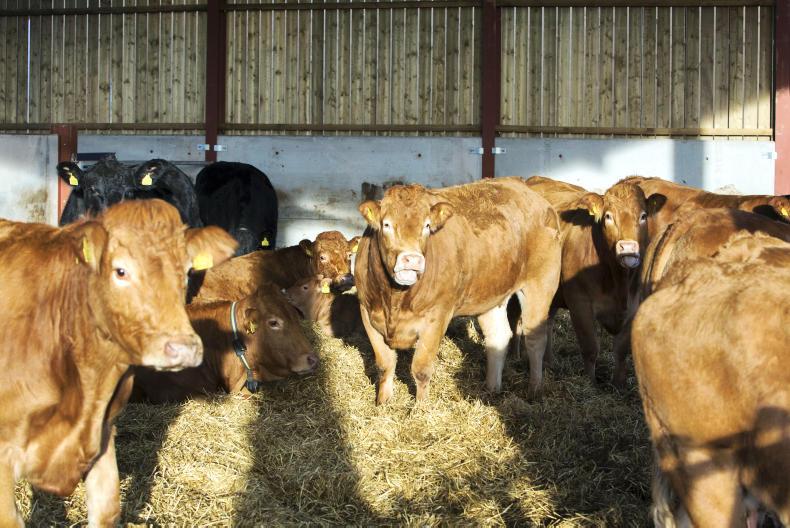Andrew Gammie farms in partnership with his wife Kathryn and father Jim at Drumforber Farm, Laurencekirk, which is close to Aberdeen in the northeast of Scotland.
Together they have established a herd of 80 suckler cows, predominantly Limousin breeding along with some Limousin crossed with Angus. The herd was only established a few years ago and has been expanding year on year with the goal of getting to 100 to 120 cows.
Stock quality is top class and the investment made in herd genetics is clearly evident when viewing the herd.
The suckler herd is run on a commercial basis with profit at the core of business decisions. Within the herd is a smaller nucleus of pedigree Limousin cows, selling breeding bulls under the Westpit prefix. Some females are flushed for embryos, which are then implanted in some commercial heifers.
While pedigree stock offer the opportunity to capture higher sale prices, commercial cattle production is still the bread and butter of the business.
The 250ha farm is in a prime arable growing area with extensive blocks of flat land. Historically, there was a close association between arable farms and livestock production in the region, but this has since changed, with very few farms now keeping livestock.
While grain and potatoes dominate farming in the region, they have suffered from a lack of profitability in recent years.
As such, Andrew sees a cattle enterprise as a good way to diversify his income stream and make greater use of the land.
Initially, some Angus cattle were kept on farm and supplied a local family-owned farm shop. The herd has grown over the past two years, with 80 cows and replacements due to calve in 2017.
Calving pattern
With the herd expanding, calving pattern has been an issue, with a prolonged pattern across spring, summer and autumn.
The autumn cows suit the pedigree side of the herd to have strong, well-developed breeding bulls for sale in spring.
The spring herd also suits the farm and offers more options to sell cattle as weanling, yearlings or as fat cattle. Plans are to move summer calving cows to spring so the herd has one large block of spring-calving cows over a 12-week period starting in February.
While the calving pattern may be spread out, cow fertility is good. The herd is part of an accredited health scheme which sees routine vaccination for disease, as well as operating a closed herd policy except for stock bulls.
Spring calving
From January to May, approximately 40 cows will calve into the herd. These have been served with a Limousin stock bull that has proved to be easily calved.
There are also 15 in-calf heifers due to calve over the spring also. These are mainly Angus and Shorthorn cross and carrying pedigree Limousin embryos. The heifers will calve at 24 months of age.
Spring-calving cows are housed in late October and weaned after two weeks of housing. This allows calves to settle indoors on to the new diet and helps to minimise stress through gradual separation from their mother.
Pre-calving diet
Once weaned, cows are condition scored. Cows carrying flesh are moved on to the dry cow diet of 1.5kg pot ale, 2.5kg wheat straw, 0.15kg minerals, 18kg silage.
Pot ale is a common feed on many farms in Scotland. It is a high-protein byproduct feed coming from the distilling of whiskey.
Straw is also a common part of the diet and next year Andrew plans to feed ammonia-treated oat straw to replace silage which is of variable quality.
Thin cows are offered a similar diet, but with an extra 1.5kg of barley and 0.15kg of soya.
Dry cows remain on this diet until calving. Cows are bolused twice per year to cover for minerals, with a pre-calving mineral offered in the final six weeks of gestation.
All cows are calved indoors, regardless of spring, summer and autumn calving. It is purely a management decision by Andrew to ease labour as there are other enterprises on the farm.
Housed cows can be easily monitored through cameras linked to the computer and phone.
New cow sheds have been constructed in 2016, with loose straw-bedded floors and calving pens, with the ability to separate and isolate cows on the point of calving for closer observation.
The dry cow diet helps to prevent cows from going over-fat and, with the purpose-built sheds, cows are much fitter at calving compared with the usual slatted pen set-up commonly found in Ireland.
Post-calving diet
January- and February-calving cows remain indoors until late April to early May. The farm is around 90 minutes north of Edinburgh and, while it is an area of low rainfall, spring growth is much later than what is typical of Ireland due to lower soil temperatures.

Cows do have milk, even with a large part of the herd being close to pure-bred Limousin. To keep cows milking in the shed before turnout, they move onto a diet of 2.5kg pot ale, 0.75kg straw, 0.15kg minerals, 0.15kg soya, 1.5kg barley (prop - corned), 30kg silage.
To manage time, cows are fed three times per week on Monday, Wednesday and Friday. There is no problem with silage heating as it is cut at a mature stage and well fermented.
Health
As the herd is part of a health scheme, the onus is on prevention rather than cure. Calving sheds are kept clean and best practice is followed as far as possible.
Cows are not vaccinated for scour. With new housing relieving stocking density while indoors and plenty of clean, dry straw bedding, there is less chance of scour being an issue.
Coccidiosis reared its head last year and steps have been taken to prevent this from recurring this spring.
Future plans
 Making the herd a viable business is a priority for the Gammie family. As such, Andrew has joined the Farm Profit Programme, which is similar to the BETTER Farm programme. His is one of six focus farms in the programme, a joint venture between the Irish Farmers Journal and ANM group, which operates the main mart service in northeast Scotland.
Making the herd a viable business is a priority for the Gammie family. As such, Andrew has joined the Farm Profit Programme, which is similar to the BETTER Farm programme. His is one of six focus farms in the programme, a joint venture between the Irish Farmers Journal and ANM group, which operates the main mart service in northeast Scotland.
Over the three-year programme, he hopes to grow the herd towards its 120-cow limit and settle into a defined calving system producing high quality in-calf replacement heifers for sale annually.







SHARING OPTIONS